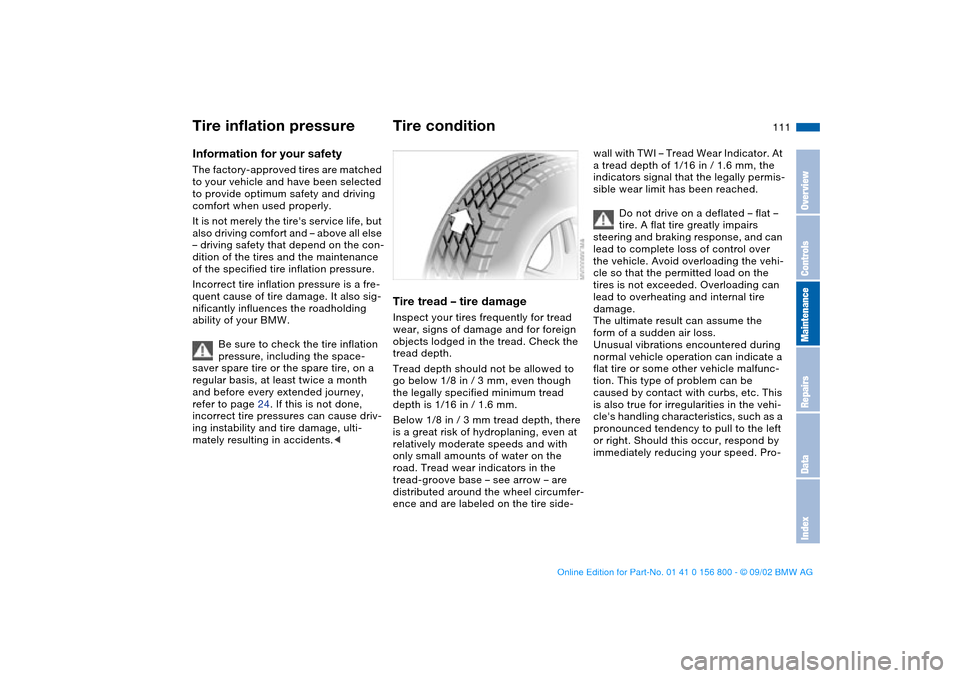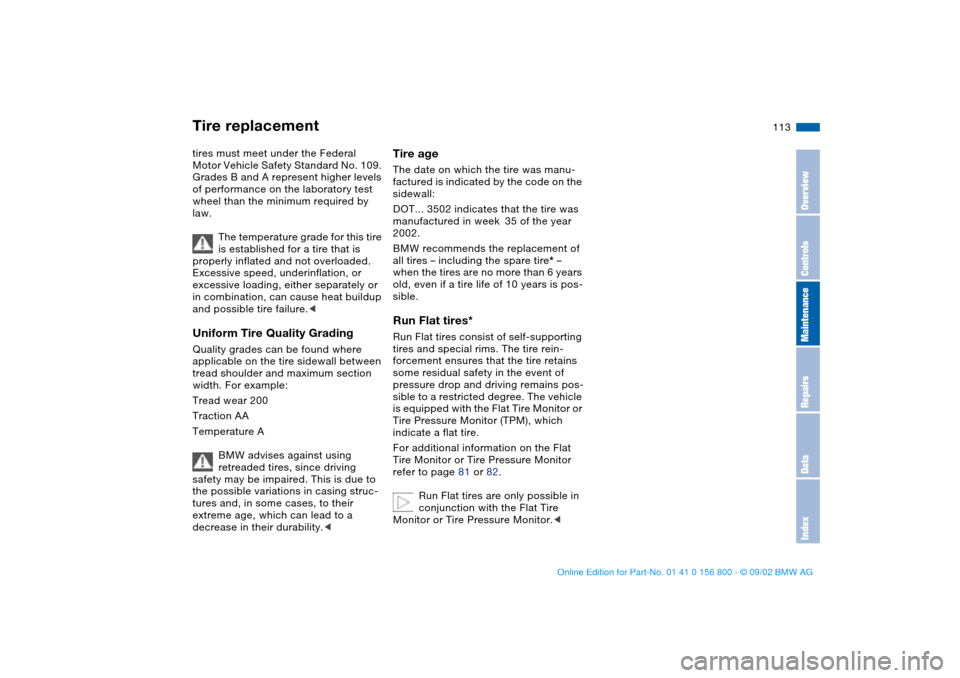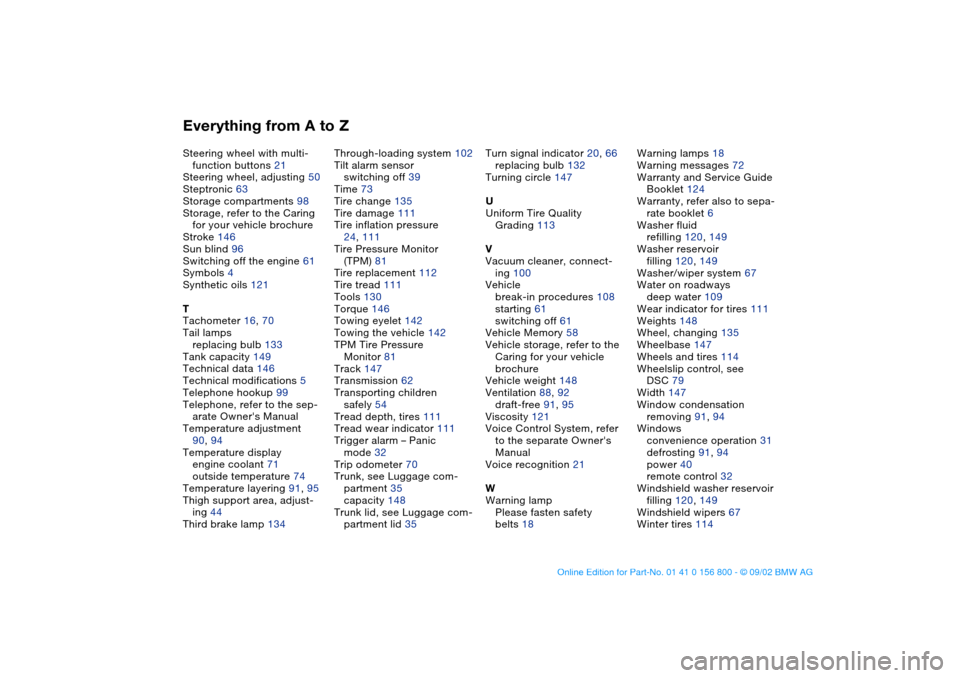2003 BMW 325Ci COUPE inflation pressure
[x] Cancel search: inflation pressurePage 84 of 162

84
Flat tire
The red warning lamp in the
instrument cluster lights up to
warn of pressure loss and tire
failure. This visual alert is accompanied
by an acoustic warning signal. Reduce
your speed immediately, and steer and
brake gently as you bring the vehicle to
a stop.
To reset the warning lamp: after replac-
ing the damaged tire you will need to
reset the red warning lamp manually:
maintain pressure on the Flat Tire Moni-
tor button until the warning lamp goes
out. Then reinitialize the system.
The Flat Tire Monitor cannot pro-
vide you with advance warning of
sudden and severe tire damage caused
by external factors.
The system also does not detect the
gradual and minor loss of pressure that
all tires display over extended periods
of time.<
Check tire inflation pressures on a
regular basis, correcting them as
necessary, refer to page 24.
The system may respond to operation
on slippery or snow-covered road sur-
faces with false warnings or delays in
detecting actual pressure loss.
Performance-oriented driving – slip at
the drive wheels, high rates of lateral
acceleration – can also increase the
time that the Flat Tire Monitor requires
to detect a flat.<
System malfunctionsThe yellow indicator lamp in the instru-
ment cluster lights up and remains on
until the problem is corrected.
Please refer the problem to your BMW
center.
Flat Tire Monitor*
handbook.book Page 84 Tuesday, July 30, 2002 12:16 PM
Page 111 of 162

111 Wheels and tires
Tire inflation pressureInformation for your safetyThe factory-approved tires are matched
to your vehicle and have been selected
to provide optimum safety and driving
comfort when used properly.
It is not merely the tire's service life, but
also driving comfort and – above all else
– driving safety that depend on the con-
dition of the tires and the maintenance
of the specified tire inflation pressure.
Incorrect tire inflation pressure is a fre-
quent cause of tire damage. It also sig-
nificantly influences the roadholding
ability of your BMW.
Be sure to check the tire inflation
pressure, including the space-
saver spare tire or the spare tire, on a
regular basis, at least twice a month
and before every extended journey,
refer to page 24. If this is not done,
incorrect tire pressures can cause driv-
ing instability and tire damage, ulti-
mately resulting in accidents.<
Tire conditionTire tread – tire damageInspect your tires frequently for tread
wear, signs of damage and for foreign
objects lodged in the tread. Check the
tread depth.
Tread depth should not be allowed to
go below 1/8 in / 3 mm, even though
the legally specified minimum tread
depth is 1/16 in / 1.6 mm.
Below 1/8 in / 3 mm tread depth, there
is a great risk of hydroplaning, even at
relatively moderate speeds and with
only small amounts of water on the
road. Tread wear indicators in the
tread-groove base – see arrow – are
distributed around the wheel circumfer-
ence and are labeled on the tire side-
wall with TWI – Tread Wear Indicator. At
a tread depth of 1/16 in / 1.6 mm, the
indicators signal that the legally permis-
sible wear limit has been reached.
Do not drive on a deflated – flat –
tire. A flat tire greatly impairs
steering and braking response, and can
lead to complete loss of control over
the vehicle. Avoid overloading the vehi-
cle so that the permitted load on the
tires is not exceeded. Overloading can
lead to overheating and internal tire
damage.
The ultimate result can assume the
form of a sudden air loss.
Unusual vibrations encountered during
normal vehicle operation can indicate a
flat tire or some other vehicle malfunc-
tion. This type of problem can be
caused by contact with curbs, etc. This
is also true for irregularities in the vehi-
cle's handling characteristics, such as a
pronounced tendency to pull to the left
or right. Should this occur, respond by
immediately reducing your speed. Pro-
OverviewControlsMaintenanceRepairsDataIndex
handbook.book Page 111 Tuesday, July 30, 2002 12:16 PM
Page 113 of 162

113
tires must meet under the Federal
Motor Vehicle Safety Standard No. 109.
Grades B and A represent higher levels
of performance on the laboratory test
wheel than the minimum required by
law.
The temperature grade for this tire
is established for a tire that is
properly inflated and not overloaded.
Excessive speed, underinflation, or
excessive loading, either separately or
in combination, can cause heat buildup
and possible tire failure.
tread shoulder and maximum section
width. For example:
Tread wear 200
Traction AA
Temperature A
BMW advises against using
retreaded tires, since driving
safety may be impaired. This is due to
the possible variations in casing struc-
tures and, in some cases, to their
extreme age, which can lead to a
decrease in their durability.<
Tire ageThe date on which the tire was manu-
factured is indicated by the code on the
sidewall:
DOT... 3502 indicates that the tire was
manufactured in week 35 of the year
2002.
BMW recommends the replacement of
all tires – including the spare tire* –
when the tires are no more than 6 years
old, even if a tire life of 10 years is pos-
sible.Run Flat tires*Run Flat tires consist of self-supporting
tires and special rims. The tire rein-
forcement ensures that the tire retains
some residual safety in the event of
pressure drop and driving remains pos-
sible to a restricted degree. The vehicle
is equipped with the Flat Tire Monitor or
Tire Pressure Monitor (TPM), which
indicate a flat tire.
For additional information on the Flat
Tire Monitor or Tire Pressure Monitor
refer to page 81 or 82.
Run Flat tires are only possible in
conjunction with the Flat Tire
Monitor or Tire Pressure Monitor.<
Tire replacement
OverviewControlsMaintenanceRepairsDataIndex
handbook.book Page 113 Tuesday, July 30, 2002 12:16 PM
Page 115 of 162

115
Tire condition, tire pressureAt tread depths below approx. 3/16 in /
4 mm, winter tires display a perceptible
decrease in their ability to cope with
winter driving conditions, and should be
replaced in the interest of safety.
Comply with the specified tire inflation
pressures – and be sure to have the
wheel and tire assembly balanced
every time you change a tire or wheel.Snow chains*BMW has assessed the safe perfor-
mance of certain specific tire brands
and approved them for use. Consult
any BMW center for details. BMW rec-
ommends using approved fine-link
snow chains only. Use them inpairs on
either summer or winter tires, but only
on both rear wheels.
Comply with all manufacturer's safety
precautions when mounting the chains.
Do not exceed a speed of 30 mph /
50 km/h when using snow chains.
You cannot mount snow chains on the
following tires:
225/50 R 16
225/45 R 17
225/40 R 18
245/40 R 17255/35 R 18Winter tires
OverviewControlsMaintenanceRepairsDataIndex
handbook.book Page 115 Tuesday, July 30, 2002 12:16 PM
Page 138 of 162

138
13. Wheels with full wheel covers*:
place the wheel cover with the
valve opening – see arrow – over
the valve. Use both hands to press
the cover securely onto the rim
14. Check and correct the tire inflation
pressure at the earliest opportunity.
Vehicles with Tire Pressure Monitor
(TPM)/Flat Tire Monitor: after
mounting the spare tire or correct-
ing the tire inflation pressure, reini-
tialize the system, refer to
pages 81, 82.
Protect valve stems and valves from dirt
using screw-on valve stem caps. Dirty
valve stems frequently lead to slow
pressure loss.
Do not attempt to install the full
wheel cover on the space-saver
spare tire, since this could damage the
cover.<
The vehicle jack is designed for
changing wheels only. Do not
attempt to raise another vehicle model
with it or to raise any load of any kind.
To do so could cause accidents and
personal injury.
To ensure continued safety, have the
tightness of the torque bolts checked
with a calibrated lug wrench – torque
specification: 88.5 lb ft/120 Nm – at the
earliest opportunity.<
When storing a wheel in the spare tire
recess, take care to avoid bending the
threaded rod.
If the original BMW light-alloy wheels
have been replaced with other light-
alloy wheels, different lug bolts may be
required.
Replace the defective tire as soon as
possible and have the new wheel/tire
balanced.
Driving with the space-saver
spare tireDrive cautiously. Do not exceed a
speed of 50 mph / 80 km/h.
Be aware that vehicle handling may be
altered. Anticipate, e.g., reduced track-
ing during braking, longer braking dis-
tances and changed steering charac-
teristics when approaching limit
conditions. These handling characteris-
tics will be even more pronounced if
winter tires are mounted.
Only one space-saver spare tire
may be mounted at one time.
Mount a wheel and tire of the original
size at the earliest possible opportu-
nity.
tions, the size of the spare tire will
differ from that of the remaining tires.
The spare tire is fully functional at all
loads and speeds. However, the spare
tire should be replaced at the earliest
possible opportunity in order to achieve
the original operating conditions.<
Changing a wheel
handbook.book Page 138 Tuesday, July 30, 2002 12:16 PM
Page 139 of 162

139
Run Flat tires*Run Flat tires are labeled on the side-
wall with a circular symbol containing
the letters RSC. Run Flat tires consist of
self-supporting tires and special rims.
The tire reinforcement ensures that the
tire retains some residual safety in the
event of pressure drop and driving
remains possible to a restricted degree.
The vehicle is equipped with the Flat
Tire Monitor or Tire Pressure Monitor
(TPM), which indicate a flat tire.
Because the sides of Run Flat
tires are reinforced, a drop in infla-
tion pressure usually cannot be
detected from the outside.<
Flat tireIf there is a tire failure, the red warning
lamp symbol lights up. This visual alert
is accompanied by an acoustic warning
signal.
Additional information on the Tire Pres-
sure Monitor or Flat Tire Monitor is
found beginning on page 81.
Reduce vehicle speed carefully to
under 50 mph / 80 km/h, avoiding hard
brake applications and steering maneu-
vers.
If it can not be determined immediately
from the outside which wheel is defec-
tive, check the tire inflation pressure at
all four wheels.
Have Run Flat tires replaced by
your BMW center. In the interest
of safety, Run Flat tires should not be
repaired. Your BMW center has the
information needed for working with
Run Flat tires and is equipped with the
necessary special tools.<
If appropriate, please consult your
BMW center to reequip your vehi-
cle from summer to winter tires – or vice
versa.<
Driving with a damaged tireRun Flat tires allow you to continue
driving to a restricted degree at a maxi-
mum speed of 50 mph / 80 km/h
depending on the cargo load and the
extent of tire damage. You can deter-
mine the distance you may continue
driving on the basis of the following val-
ues:
>Tire inflation pressure of 0 psi/
0 kilopascal (kPa):
approx. 100 miles/150 km
>Tire inflation pressure of approx.
7-15 psi/50-100 kPa:
approx. 300 miles/500 km
>Tire inflation pressure greater than
15 psi/100 kPa:
approx. 600 miles/1,000 km.
Drive cautiously. Do not exceed a
speed of 50 mph / 80 km/h. Be
aware that vehicle handling will be
altered when there is a loss in inflation
pressure. Anticipate, e.g., reduced
tracking during braking, longer braking
distances and changed steering char-
acteristics.<
OverviewControlsMaintenanceRepairsDataIndex
handbook.book Page 139 Tuesday, July 30, 2002 12:16 PM
Page 154 of 162

Everything from A to ZFuel tank
capacity 149
display 71
gauge 71
Fuel-injection system 146
Fuses, replacing 140
G
Gasoline 24
Gasoline gauge 71
Glove compartment 97
Grills 88, 92
Gross vehicle weight 148
H
Hands-free system 99
Harman Kardon premium
sound system 97
Hazard warning flashers 14
Hazard warning triangle 22
Head airbags 52
Head restraints 46
Headlamp flasher 86
Headlamp washer system
120, 149
Headlamps 85
automatic control 85
Heated seats 49
Heating and ventilation 92
Heavy loads 104
High beams 20, 66, 86
replacing bulb 131Holder for
beverages 98
litter bag 99
Hood release 116
Horn 14
Hydraulic brake assistant,
see DBC
Hydroplaning 109, 111
I
Ice warning 74
Icy roads 74
Ignition key 30
Ignition lock 59
Imprint 4
Indicator lamps 18
Inflation pressure 24, 111
monitoring 81
INSPECTION 72
Instrument cluster 16
Instrument lighting 86
Instrument panel 14, 16
Interface socket for onboard
diagnostics 126
Interior lamps 32, 87
remote control 32
Interior motion sensor 38
switching off 39
Interior rearview mirror 51
automatic dimming
feature 51
Interlock 59Intermittent mode 67
J
Jack 135
Jump-starting 141
K
Key Memory 58
Keys 30
with remote control 30
L
Lamps, replacing 131
LATCH child-restraint
mounting system 56
Length 147
License plate lamp
replacing bulb 135
Light switch 85
Lighter 100
LIGHTS ON warning 85
Litter bag holder 99
Load-securing devices 105
Lock, steering wheel 59
Low beams 85
automatic 85
replacing bulb 131
Lug wrench 135
Luggage compartment 35
capacity 148
floor mat 38
floor panel 37Luggage compartment lid 35
emergency operation 35
emergency release 37
remote control 32
securing separately 35
Luggage compartment light-
ing 35
Luggage rack 105
Lumbar support 45
M
M+S tires 114
Maintenance 72, 124
Malfunction displays 72
Manual transmission 62
MC operation, refer to the
Owner's Manual for Radio
MD operation, refer to the
Owner's Manual for Radio
Memory 48
Memory settings 58
Microfilter 91, 96
Microphone 99
Mirror
automatic curb monitor 49
Mirror defrosting 50
Mirror memory 48
Mirrors 50
Modifications, technical 5
Multifunction switch 66
handbook.book Page 154 Tuesday, July 30, 2002 12:16 PM
Page 156 of 162

Everything from A to ZSteering wheel with multi-
function buttons 21
Steering wheel, adjusting 50
Steptronic 63
Storage compartments 98
Storage, refer to the Caring
for your vehicle brochure
Stroke 146
Sun blind 96
Switching off the engine 61
Symbols 4
Synthetic oils 121
T
Tachometer 16, 70
Tail lamps
replacing bulb 133
Tank capacity 149
Technical data 146
Technical modifications 5
Telephone hookup 99
Telephone, refer to the sep-
arate Owner's Manual
Temperature adjustment
90, 94
Temperature display
engine coolant 71
outside temperature 74
Temperature layering 91, 95
Thigh support area, adjust-
ing 44
Third brake lamp 134Through-loading system 102
Tilt alarm sensor
switching off 39
Time 73
Tire change 135
Tire damage 111
Tire inflation pressure
24, 111
Tire Pressure Monitor
(TPM) 81
Tire replacement 112
Tire tread 111
Tools 130
Torque 146
Towing eyelet 142
Towing the vehicle 142
TPM Tire Pressure
Monitor 81
Track 147
Transmission 62
Transporting children
safely 54
Tread depth, tires 111
Tread wear indicator 111
Trigger alarm – Panic
mode 32
Trip odometer 70
Trunk, see Luggage com-
partment 35
capacity 148
Trunk lid, see Luggage com-
partment lid 35Turn signal indicator 20, 66
replacing bulb 132
Turning circle 147
U
Uniform Tire Quality
Grading 113
V
Vacuum cleaner, connect-
ing 100
Vehicle
break-in procedures 108
starting 61
switching off 61
Vehicle Memory 58
Vehicle storage, refer to the
Caring for your vehicle
brochure
Vehicle weight 148
Ventilation 88, 92
draft-free 91, 95
Viscosity 121
Voice Control System, refer
to the separate Owner's
Manual
Voice recognition 21
W
Warning lamp
Please fasten safety
belts 18Warning lamps 18
Warning messages 72
Warranty and Service Guide
Booklet 124
Warranty, refer also to sepa-
rate booklet 6
Washer fluid
refilling 120, 149
Washer reservoir
filling 120, 149
Washer/wiper system 67
Water on roadways
deep water 109
Wear indicator for tires 111
Weights 148
Wheel, changing 135
Wheelbase 147
Wheels and tires 114
Wheelslip control, see
DSC 79
Width 147
Window condensation
removing 91, 94
Windows
convenience operation 31
defrosting 91, 94
power 40
remote control 32
Windshield washer reservoir
filling 120, 149
Windshield wipers 67
Winter tires 114
handbook.book Page 156 Tuesday, July 30, 2002 12:16 PM